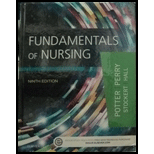
Concept explainers
To determine:
Three days after the person (L) is being admitted and reports that reduced shortness of breath; but she is tired, irritable and restless. The patient is on a cardiac monitor and continues to receive oxygen. The nurse reports that the person (L) has slept very little since her admission. Her semiprivate room is direct across from a busy central nurse’s station. She frequently calls out for assistance. Find the sensory alteration of the person (L) is experiencing and three strategies that will ensure that she gets enough sleep?
Concept introduction:
The person (L) made an informed decision to have cataract surgery 1 month ago. Later the surgery, the patient reported that ability to participate in activities of daily and living and improved vision. The nurse from community health care visits the patient today, and the person (L) reports shortness of breath with activity. The nurse consults afterwards with the health care provider of the person (L), that he is admitted from the emergency department to a telemetry heart monitoring unit with a diagnosis of heart failure.
Explanation of Solution
There are three common types of sensory alterations includes sensory deprivation, sensory deficits and sensory overload. If the person suffers from sensory alteration more than one, then the individual’s effective understanding within the environment and ability to function is impaired seriously.
- 1) Sensory deficits: A deficit is the common function of sensory perception and reception is called a sensory deficit. When an individual loses hearing and visual, he or she leaves by preventing socialization and communication with others in an attempt to cope with the sensory loss. It becomes difficult for the individual to communicate safely with the environment til he or she experience new skills. The person feels far away because of impotence to communicate with others and it is caused by sensory deficits.
- 2) Sensory deprivation: All the sensory stimuli to the cerebral cortex are mediated by the reticular activating system that presents in the brainstem and able to receive stimuli even at the period of sleeping intensely. The sensory stimulation should be of enough quality and amount to maintain an awareness of the person. There are three types of sensory deprivations includes the restrictive environments, elimination of patterns or meaning of input, and reduced sensory input (sensory deficit from hearing or visual loss).
- 3) Sensory overload: A person experiences several stimuli and cannot particularly disregard or perceptually ignore some stimuli, in that condition a sensory overload happens. The uncontrolled sensory overload stimulation avoids the brain from disregarding particular stimuli or responding appropriately. The sensory overload avoid the meaningful response by the brain such as attention scatters in several direction, restlessness, patient’s thought race and anxiety occur.
The sensory alteration that the person (L) experiencing in the given case is sensory overload. Three strategies that will make sure that person (L) gets enough sleep is to provide some time for rest and calm without any distraction, incorporate particular routine activities such as bathing, changing and medicine intake and monitor changes in vital signs.
Strategies to avoid the sensory overload, control stimuli and direct the patient to the environment and the approaches implemented to get enough sleep for the person (L) is explained.
Want to see more full solutions like this?
Chapter 49 Solutions
Fundamentals of Nursing - Package
 Phlebotomy EssentialsNursingISBN:9781451194524Author:Ruth McCall, Cathee M. Tankersley MT(ASCP)Publisher:JONES+BARTLETT PUBLISHERS, INC.
Phlebotomy EssentialsNursingISBN:9781451194524Author:Ruth McCall, Cathee M. Tankersley MT(ASCP)Publisher:JONES+BARTLETT PUBLISHERS, INC. Gould's Pathophysiology for the Health Profession...NursingISBN:9780323414425Author:Robert J Hubert BSPublisher:Saunders
Gould's Pathophysiology for the Health Profession...NursingISBN:9780323414425Author:Robert J Hubert BSPublisher:Saunders Fundamentals Of NursingNursingISBN:9781496362179Author:Taylor, Carol (carol R.), LYNN, Pamela (pamela Barbara), Bartlett, Jennifer L.Publisher:Wolters Kluwer,
Fundamentals Of NursingNursingISBN:9781496362179Author:Taylor, Carol (carol R.), LYNN, Pamela (pamela Barbara), Bartlett, Jennifer L.Publisher:Wolters Kluwer, Fundamentals of Nursing, 9eNursingISBN:9780323327404Author:Patricia A. Potter RN MSN PhD FAAN, Anne Griffin Perry RN EdD FAAN, Patricia Stockert RN BSN MS PhD, Amy Hall RN BSN MS PhD CNEPublisher:Elsevier Science
Fundamentals of Nursing, 9eNursingISBN:9780323327404Author:Patricia A. Potter RN MSN PhD FAAN, Anne Griffin Perry RN EdD FAAN, Patricia Stockert RN BSN MS PhD, Amy Hall RN BSN MS PhD CNEPublisher:Elsevier Science Study Guide for Gould's Pathophysiology for the H...NursingISBN:9780323414142Author:Hubert BS, Robert J; VanMeter PhD, Karin C.Publisher:Saunders
Study Guide for Gould's Pathophysiology for the H...NursingISBN:9780323414142Author:Hubert BS, Robert J; VanMeter PhD, Karin C.Publisher:Saunders Issues and Ethics in the Helping Professions (Min...NursingISBN:9781337406291Author:Gerald Corey, Marianne Schneider Corey, Cindy CoreyPublisher:Cengage Learning
Issues and Ethics in the Helping Professions (Min...NursingISBN:9781337406291Author:Gerald Corey, Marianne Schneider Corey, Cindy CoreyPublisher:Cengage Learning





